|
CHAPTER IX. KILKENNY TO CORK HARBOUR IF Lismore is the most celebrated and stately of Irish castles, Kilkenny, at least, comes more nearly to the popular conception of the feudal stronghold of the romancers and poets, and, withal, it is historic and is second in preeminence, only, to any other in the land. Kilkenny itself is an ancient city, and it is something of a city as the minor centres of population go. “Does it not contain,” says the proud inhabitant, “nearly fifteen thousand souls?” It does, indeed, but it is more justly famous for its archæological remains than for its manufactures of woollens, which formerly was great. Probably the most novel impression the stranger will get of Kilkenny will be that which he gains at the annual agricultural show or fair, when the effect produced by the cheering of the crowds will sound unlike anything ever heard elsewhere. It is a fact that this cheering is peculiar to Kilkenny. These are no hurrahs of the ordinary British kind, but every time the feelings of the people find a vent, a long, shrill wail resounds over the fields, rising and falling, at its loudest, like the shriek of a steamer’s siren, and, when more subdued, like the moaning of a winter wind. Perhaps this is the modern descendant of the banshee’s wail. The history of the modern political and social events which took place at Kilkenny, in times past, make curious and interesting reading. Many “parliaments” were held here, and, in 1367, one of them ordained that death should be the punishment of any Englishman who married an Irishwoman. This was manifestly bigoted, uncharitable, and unkind, and no wonder that here, and elsewhere in Ireland, English domination has so often been reviled. Its most famous and important political function took place in 1642, when was held the Rebel, or Roman Catholic, Parliament, which gave to Kilkenny the name of “The City of Confederation,” though the same act culminated in its siege by Cromwell, and its ultimate downfall into the hands of “the Protector.” The outcome of all this to-day has been the indissoluble endearment of Kilkenny to all Irishmen of “the faith.” The history of Kilkenny’s famous castle is more acceptable to those who love Ireland in a familiar way. It is famous, some one has already said, as being “one of the few places where Cromwell treated an Irish gentleman politely.” The chronology of this stronghold of the middle ages — still the seat of the Marquis of Ormonde, the founder of whose ancestors, Theobald FitzWalter, was one of the retinue of Henry II. — is as follows: It was built in 1195 on the site of a former edifice, erected by Strongbow in 1172. Donald O’Brien destroyed it in the following year, but again it took form as the ancestral home of a race of men whose members have all figured more or less prominently in Irish annals since the coming of the Normans. It is one of the most ancient habitable buildings in the land, and also one of the most picturesque. Its massive gray towers and ivy-grown walls stand high upon a natural rampart and overlook the slow-drifting river. The old stone bridge that spans this river here mayhap was often crossed by Congreve and Swift on their way to school in the city. Above, the castle rises boldly against the wistful blue of Irish skies, while at night it looks like a true palace of enchantment when the moon rises beyond its turrets and towers, and throws indistinct, distorted, and mysterious shadows on the river’s surface. One feels a sense of complete repose, — but a repose that is interrupted by the occasional shriek of a locomotive, the drowsy bell of some convent, or the sharp notes of a military bugle. 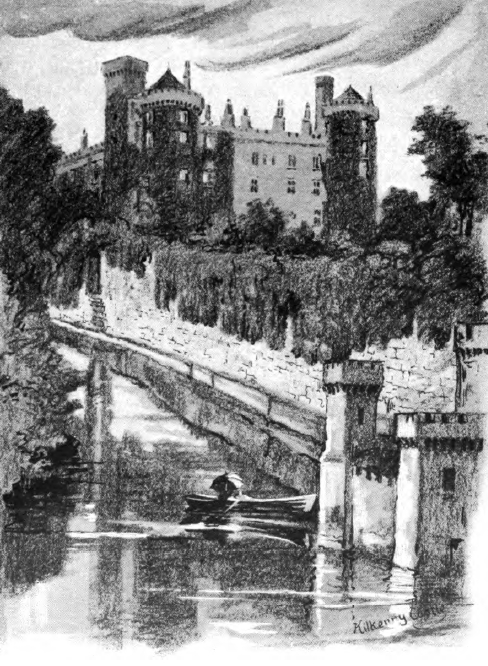 KILKENNY CASTLE. A later Theobald became the sixth Butler of Ireland, and was made the Earl of Carrick. His son was created Earl of Ormonde, and married Eleanor de Bohun, the granddaughter of Edward I. The second earl, James, became known as “the Noble Earl,” from being the great grandson of Edward I., and became Lord Chief Justice of Ireland, and he it was, the second earl of the house of Ormonde, — the direct ancestor of the present marquis, — who, in 1391, acquired the castle from another branch, which had sprung from Theobald FitzWalter. The Ormondes were a true race of noblemen, as history tells, although their story is too elaborate to chronicle completely here. The fourth earl, it is said, — by tradition, of course, and in this case quite unsupported, — was favoured by the sun’s having remained stationary in its course long enough for him to have achieved a victory over a hereditary enemy. The fifth earl became Lord High Treasurer of England, but was unfortunately beheaded, so his career did not end exactly gloriously. The sixth earl was smitten by the fervour of the Crusades and died in Jerusalem, and one of the daughters of the seventh earl married Sir William Boleyn and became the mother of the unfortunate Queen Anne, and grandmother of Elizabeth. One of the most famous men of the line was James, the twelfth earl, who, for services to Charles I., was created a marquis and raised to a dukedom by Charles II. Bishop Burnett states that “He was of graceful appearance, a lively wit, and a cheerful temper; a man of great expense, but decent even in his vices, for he always kept up the forms of religion; too faithful not to give always good advice, but, when bad ones were followed, too complaisant to be any great complainer.” For thirty years he was Chief Governor and Lord Lieutenant of Ireland, when he incurred the hatred of a bold rascal, Thomas Blood, the son of a black-smith, and a staunch supporter of Cromwell. After the Restoration even, Blood plotted against royalty, one of his schemes being to surprise Dublin Castle and to seize the lord lieutenant. This plot was discovered, and Blood managed to escape, though his accomplices were hanged. Blood swore that he who ordered their execution should share their fate. A price was set upon the scoundrel’s head, but he came to London, and set about his vengeance on the Duke of Ormonde. The Earl of Ossory, the duke’s son, joined the invading forces of William of Orange, fought for him at the Battle of the Boyne, and entertained him sumptuously at Kilkenny Castle. Later, he became a favourite of Queen Anne, and succeeded Marlborough as commander-in-chief of the land forces of Great Britain. Suspected of plotting for the Stuarts, he was attainted, his estates confiscated, his honours extinguished, and a price set upon his head by the Parliament of George I. The titles being extinguished, the earl’s brother was allowed to purchase Kilkenny Castle; but neither he nor his heirs and successors assumed the titles until 1791, when the Irish Parliament decided that the Irish Act of Attainder affected estates only, and not Irish titles, though the English attainder included the loss of both. The Earldom of Ormonde, a purely Irish title, was therefore restored to John Butler, who became seventeenth in the line. The rank due to earls’ daughters was allowed to his sisters, of whom Lady Eleanor became famous as one of the eccentric recluses known as the Ladies of Llangollen. The eighteenth earl was created a marquis in 1816. A writer in a recent review recounts a visit to Kilkenny Castle which presents a wealth of detail that makes interesting reading for the inquisitive. Among other things, she says, — assuredly it was a person of the feminine persuasion who wrote: “In the evening there was a great reception at the castle of the county gentry, about four hundred ladies and gentlemen being included. If the castle was picturesque in the day, it was doubly so at night. The town itself was illuminated by countless fairy lamps, which marked the lines of the streets with points of light, and outlined the old stone bridges which cross the little river Nore, and — as it should — the full moon rose in a sapphire sky behind the castle, whose shadow fell softly upon the placid mirror of the water below, and the pale moonlight gleamed upon the white houses and walls of the lower town. Every hotel and inn — and there are many from some unexplained reason — was crowded with guests invited to the castle, while in the doorways one caught glimpses of officers in uniform and levee dress, and women in white gowns with jewels that flashed in the lamplight, waiting for their carriages and coaches to convey them to the castle entrance. Many of their vehicles were of strange archaic shape, and might have done service in Kilkenny when William the Silent was the guest of another Lord Ormonde in the days of long ago. The streets were crowded with Kilkenny folk in quaint old-world garments, — men in broad-brimmed, low-crowned hats, gray breeches, and stockings, and others with leaden buckles; women with shawls over their heads; here and there a monk in brown habit with rope girdle, and groups of soldiers. “Meanwhile, at the castle a brilliant scene was taking place in the long picture-gallery, with its priceless paintings by old masters, where the guests were being received. In the adjoining dining-room, glowing in the candlelight, gleamed the wonderful and historic gold plate of Kilkenny Castle, estimated to be worth a million and a quarter sterling. “It was much after midnight before the guests left the castle, and far into the early hours the city of Kilkenny was noisy with the merriment of its citizens, who were loath to end a day that will be long remembered in their history.” The above account is quoted here because it seems, to the writer, to present in a few words the conventionalities of the occasion in a frame of picturesqueness and environment which similar functions “in town” lack in almost every way. Certainly, convention is robbed of half its banality and insincerity under such conditions, and, though most of us know it only in costume novels, sword-and-cloak dramas, and comic-opera settings, it is pleasurable to know that such things do really exist to-day. 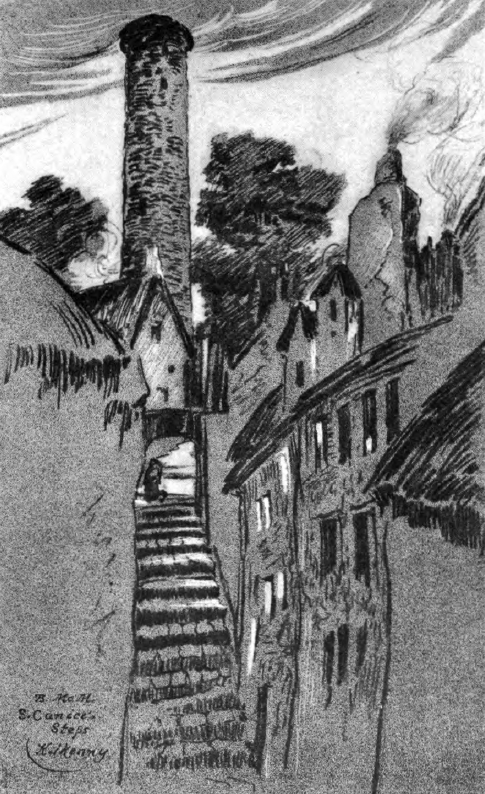 ST. CANICE’S STEPS AND THE ROUND TOWER, KILKENNY. In our day, Kilkenny Castle has been repaired, preserved, and restored, as was its due, but with that paternal care and affection which would not allow a child to be ill or inappropriately dressed. The adaptations and modernizations have not discounted its grand towers, battlements, and bastions, and though, chiefly, it is a modern building which contains the greater part of the domestic establishment of the present Marquis of Ormonde, the three massive central towers stand to-day practically unaltered as to their walls. In every way the castle suggests Spenser’s epithet, “Faire Kilkenny.” Its picture-gallery reputedly contains the best private collection in Ireland, — portraits by Holbein, Lely, Van Dyck, Kneller, and Sir Joshua, of men who have illustrated those tragedies of history which, with time, have assumed the rich colouring of romance. Their curious watchful eyes have scanned royal guests; indeed, more than one of that now silent company have intermarried with the scions of royalty. In Kilkenny itself — though, for that matter, the castle abuts upon the Market Place — is the Cathedral of St. Canice, founded about 1180, which is the gem of Kilkenny’s architectural remains. It is a cruciform church in plain, simple Gothic style, small but stately, and has in its collection of monuments the most varied and rich in Ireland. It also possesses the “Chair of St. Kieran.” Both the east and the west windows are notable, and there is a well-preserved round tower over one hundred feet high at the corner of the south transept. St. John’s (thirteenth century), with some beautiful windows; St. Mary’s, older even than the cathedral; the Black Abbey; the Franciscan Friary; and the modern Roman Catholic Cathedral complete the galaxy of ecclesiastical monuments of Kilkenny. The Blackwater River is called by the guide-books one of the largest in Ireland. The description is, however, misleading. It is neither a very great river, a very long one, nor a very important one in the world of commerce; but it is, truly, a romantic and picturesque one. Its panorama presents the following views, which are highly important and interesting: 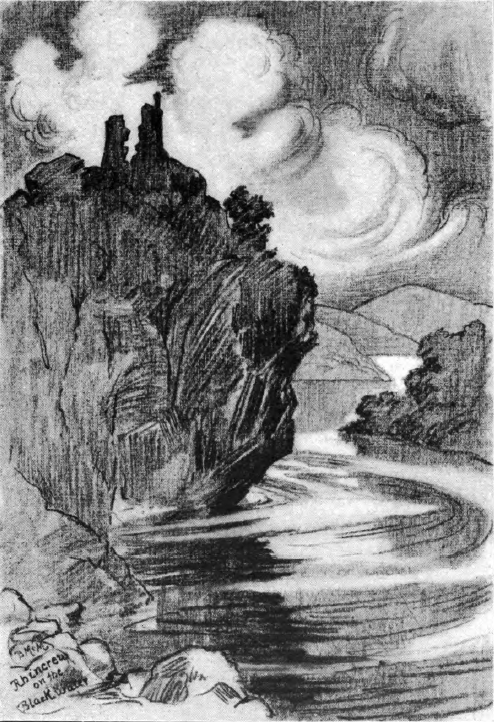 RHINCREW CASTLE. Just above the bridge on Youghal quay (Youghal derives its name from yew-wood) rises a cliff which is surmounted by a ruined Knights Templars’ preceptory, known as Rhincrew Castle and founded by Raymond le Gros in 1183. Ardsallat follows; and the square castle keep of Temple Michael, one of the ancient fortresses of the Geraldines, is near Ballintra. On the island of Molana are the ruins of the Abbey of Molanfidas, a most ancient institution, founded by St. Fachman in 501. Raymond le Gros is claimed to have been buried here, but no definite trace of the exact location appears to be known. Northward and westerly, to its source near Killarney, the Blackwater — most picturesquely and significantly named — is a unique succession of attractions such as is lacked by most streams of its size. Strancally Castle is now but a moss-grown rock; but it possesses a traditional tale of horror, which gives the waters at this point the name of “The Murdering Hole.” The Knockmeledown Mountains, a bare, bleak range, stand out to the northward in strong contrast to the fertile river-bottom. Dromona Castle, in part a modern structure, which abuts upon a more ancient structure, is the remains of an old castle of the Fitzgeralds. This ancient building was the birthplace of the Countess Catherine Desmond, who died only, at the age of 140 years, by reason of having fallen from a cherry-tree. It is not recorded as to how or why this sprightly old lady came to be in, or up, a cherry-tree on that fatal occasion, but Sir Walter Raleigh is blamed for the whole affair, in that he first domesticated the cherry-tree in Ireland, having brought the first member of that family from Grand Canary and replanted it near by. At the bend of the river, where it turns sharply to the westward, the steamboat journey of the tourist comes abruptly to an end at the most lovely and interesting of all the kaleidoscopic views which it exhibits, — the little town of Cappoquin. Cappoquin is a quaint townlet of perhaps a thousand souls and a single inn, and high above it rises the long ridge of Mount Melleray, capped, in its turn, by a Trappist convent, which carries on an industrial enterprise of the first rank. 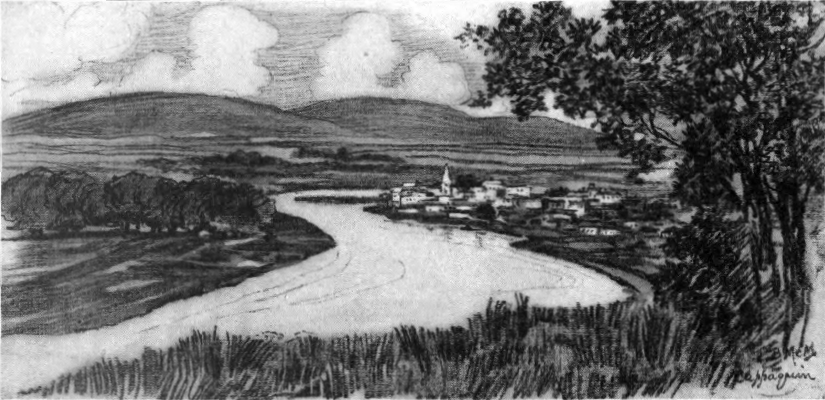 CAPPOQUIN. The Abbey of Mount Melleray lies at the foot of the Knockmeledowns, and is an institution traditionally celebrated as being the domicile of the most severe and rigorous monkish discipline; unequalled elsewhere in any land. The monks are, by their rules, vegetarians, and they observe the rule punctiliously. They drink no stimulants, not even tea, — which is probably a good thing, — and five or six hours’ sleep suffices for their resting moments. The rest is work, incessant and laborious, and, greatest hardship of all, — at least it will seem so to many of us, — is that they preserve a “discreet and wholesome silence” at all times, this rule being only relaxed in their necessary intercourse with visitors and the outside world. Of course, this procedure does not differ greatly from the general practice in the monasteries of the Trappists elsewhere, except that it is more punctiliously observed here. The abbey was originally a foundation of the Cistercian monks, who were driven from France by the Revolution of 1830; but to-day it is peopled by natives of Ireland. In all this region, no castle, country-seat, abbey, or church is more famous or splendid than Lismore Castle, another foundation of the Earl of Montaigne, afterward King John of England (1185). It is to-day the Irish home of the Duke and Duchess of Devonshire. Lismore Castle is one of the most beautiful seats in all Ireland. It has even been mentioned, among the people here, as a prospective royal residence, though, like enough, this is not to be taken as anything more than irresponsible gossip, based on a wish that is father to the thought. It has been in the possession of the Cavendish family since 1748, and the Duke and Duchess of Devonshire spend some time every year in residence here in the midst of their Irish tenantry. Royalty has frequently visited Lismore Castle. It was an ancient fortress, and dates back to the days of King John. It has been the scene of many a hard-fought fight, especially in the wars of the Commonwealth, when Lord Castlehaven captured it from the Roundheads in 1645. The present Duke of Devonshire and his predecessor have modernized the castle and equipped it with interior luxuries without interfering in any way with its noble and hoary exterior. 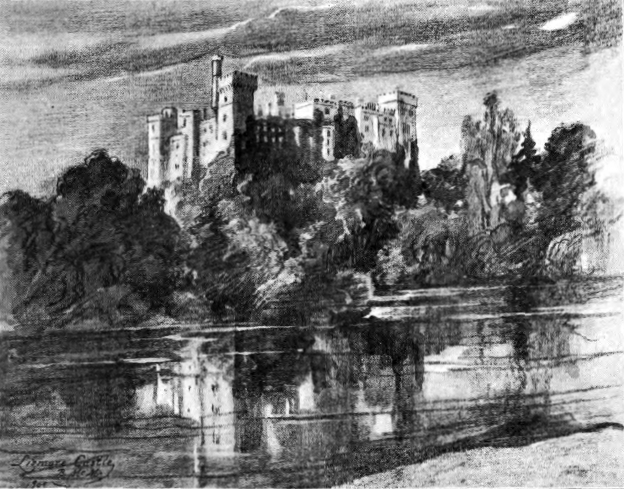 LISMORE CASTLE. Lismore is in the very heart of the Blackwater country, amid some of the most lovely scenery in the south of Ireland. Through Lismore Glen, where the woods are thick on either side and the road is canopied over with the spreading green foliage, one enters the Gap, a famous pass in the Knockmeledown Mountains, where the hills rise on one side to frowning heights, crowned in the gold of the gorse, which gives an additional glory to the land, and, on the other side, fall sheer down in an almost precipitous steep, across which there is a vast and enchanting view over the rolling plains of Tipperary. As one passes through the Gap, either on a car or coach, or on foot, the sun streams down with dazzling brightness, and the little villages and townships, the tapering spires, the tall watch-towers of antiquity, the whitewashed cottages, and gray stone houses, standing solitary on green fields, the ranges of purple hills, and the clumps of woods are all suffused with the yellow mellowing glow of a glorious summer sun. To all who visit the Blackwater, Lismore should be doubly dear; first, because of its being a fine example of the fortified domestic Gothic architecture of its time, and, secondly, because its present occupant is generous enough to open its interior to view. A MS. of very ancient date was recently discovered by some workmen repairing the older portion of the castle. It is a most precious work on vellum, recounting contemporary history in a manner which classes it as one of the famous chronicles of English history, worthy, perhaps, to rank with Froissart, Doomsday, and St. Albans. It is known as the “Book of Lismore,” and is now considered one of the chief treasures of the castle. One leaves Lismore with a certain feeling of sadness, if he is observant and studies the straws and the winds. Not many years ago the long mountain road, which runs from Lismore to the Knockmeledown Mountains, had four or five little hamlets dotted along it; to-day scarcely one house remains, and hardly a sign of life, except a few sheep snatching at the precarious grazing. Of the 42,000 acres belonging to the Duke of Devonshire, only half are under cultivation, and this is a very large proportion compared to the rest of the surrounding estates. Lismore, the town, has itself shrunk considerably during the past few years. The aching desolation of it all gets on one’s nerves after a time, and, during a sojourn in this beautiful region, admiration of the scenery is mingled with wonder as to whether nothing can or ever will be done to brighten the mournful economic aspect of the agrarian situation. Irish names have often a knack of being frankly pugnacious, so that even a peaceful lord chief justice has had to bear the inciting-to-murder sobriquet of Killowen. But the mountains, which form the background to Lismore and Clogheen, the Knockmeledowns, are capable of an entirely pacific interpretation. Commonly one says, “We are knocked down all in a heap” by this or that which takes us by surprise, and these mountains surprise all by their beauty. There is no lovelier sight in Ireland, and, if an air of melancholy prevails, it is because the scene is “somehow sad by excess of serenity,” to quote a recent phrase of Mr. Henry James, concerning a similar aspect elsewhere. Between Lismore and Cork, via Mallow, is Mitchelstown, which presents an unusual series of attractions of the purely sentimental order. Mitchelstown’s Castle, Skereenarint (a “place for dancing in the wood”), and the Caves of Coolagarranroe are the chief points of interest. It is also the seat of an ancient bishopric, founded by St. Carthage in the seventh century. Health-giving and time-honoured Mallow, famed of Tacitus (Hist., lib. i., c. 67) as the locus amoens salubrium aquarium frequens, is hardly of great moment for the traveller of to-day, except as the gateway from the north to Killarney. Just north of Mallow, in the County Cork, is the rushing river Awbeg, the “Mulla bright and fair,” “Mulla mine,” of Spenser. The poet himself lived at Kilcoman Castle, some six miles off. Near by is Buttevant, the Boutez-en-Avant, derived from the war-cry of David de Barry. Significantly and strongly French, it reminds one of the “Push forward” manœuvre of Barry’s men against the followers of MacCarthy. The old name of this place was Kilnamullach, i. e., Church of the Curse. The abbey in ruins reminds one that it was — “Once
the seat
Of monkish ease and dark religious pomp: There many an antique monument is found Illegible and faithless to its charge.” “That, deep insculped, once held in measured phrase The mighty deeds of those who sleep below, Of hero, sage or saint, whose pious hands — ” Cashel, known as “Cashel of the Kings,” was the residence of the ancient Kings of Ulster. The famous rock of Cashel is an eminence which rises abruptly above the surrounding plain, and holds upon its summit a grand assemblage of windowless and roofless ruins. These include various ecclesiastical buildings and monuments of a great age, — a cathedral, Cormac’s Chapel, an episcopal palace, and various other edifices. Cormac’s Chapel and its round tower, commemorating the virtues of Cormac MacCullinan, “at once King and Archbishop of Cashel,” are justly reckoned as among the best preserved and most curious erections in the country. In that they were supposed to have been erected in Cormac’s time (he was born in 831), they certainly must be considered as in a remarkable state of preservation, and, in every way, chronicles in stone of the first importance. Cormac has ascribed to his credit, too, the celebrated “Psalter of Cashel” and “Cormac’s Glossary,” though there appears to be some doubt as to whether he was the author or patron who inspired the production of these works. The “pointed” cathedral is of later date, and was, in part, destroyed by fire in 1495. To-day it is a ruin, but a magnificent one, and its outlines and proportions mark it as an important landmark for miles around the great plain which surrounds “the rock.” The round tower’s exact history is obscure; but, like most of its fellows, it is of undoubted Christian significance. Twenty feet from the ground, it is connected with the cathedral itself, while its completed height rises ninety feet or more. Curiously enough, it is constructed from quite a different stone from that used in the other buildings on the rock, and the supposition is that it stood for centuries, silent and solitary, before the cathedral itself took form, and perhaps before even Cormac’s Chapel. The Cross of Cashel is another celebrated feature of artistic and historical worth. The “rock” was originally surrounded by a wall, which, though now gone nearly to ruin, gives indications of great strength. In 1647 it was stormed by Lord Inchquin, who took it and put to death the clergy who had taken refuge thereon. END OF VOLUME I. 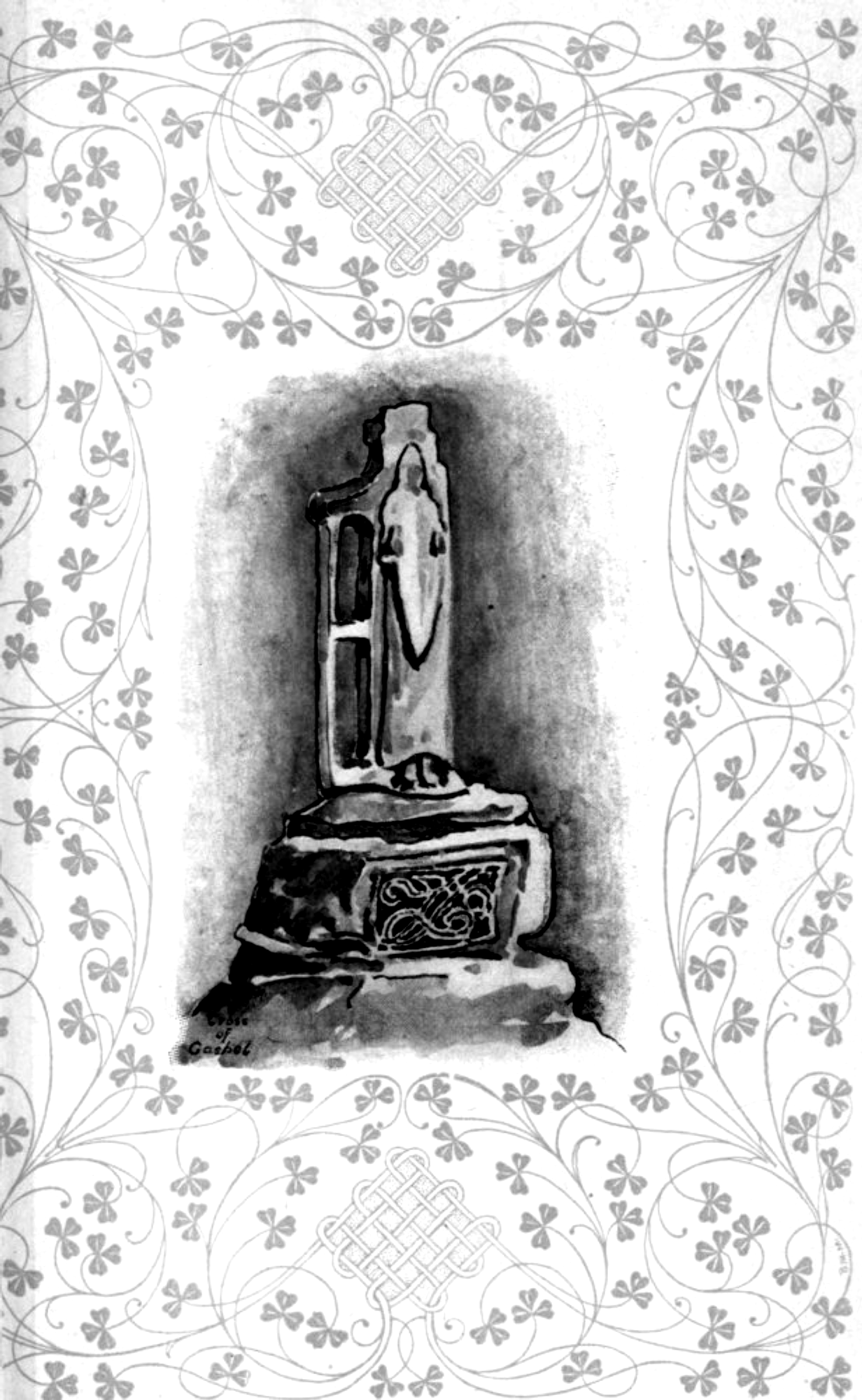 The Cross of Cashel |
Web and Book design,
Copyright, Kellscraft Studio
1999-2017
(Return to Web Text-ures)
